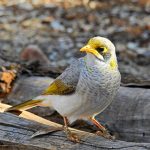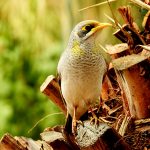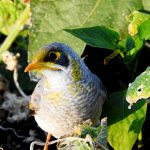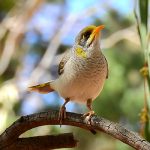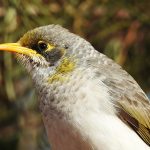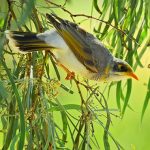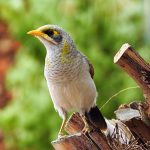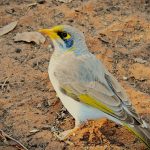YELLOW-THROATED MINER
Sharon: I have seen a few of these happy Miners on our travels, mainly inland. They are just as curious as their relatives the Noisy Miners except they really do have some pale, yellow throat feathers, as the name implies.
The Yellow-throated Miner: A Portrait of an Australian Native
Imagine a bright morning in the heart of Australia’s open woodlands. The sun filters through slender eucalyptus leaves, casting dappled light onto the ground below. Amidst this natural tapestry, a lively chorus rises—a melody belonging to one of Australia’s most adaptable and distinctive birds: the Yellow-throated Miner.
Where You’ll Find Them
The Yellow-throated Miner is a true Australian, calling almost every corner of the continent home—except for the densest forests and the driest deserts. Its preferred habitats include:
- Open woodlands filled with tall eucalyptus
- Acacia scrublands that stretch across the outback
- Urban parks and gardens, where native trees offer shelter and food
Whether wandering through mulga scrub or city green spaces, you are likely to encounter these birds, especially if you pause to listen to their clear, melodic calls echoing through the trees.
Distinctive Appearance
| Feature | Description |
|---|---|
| Size | 24–28 cm in length |
| Plumage | Soft greys, with a pale belly |
| Throat Patch | Bright yellow, namesake feature |
| Face | Black mask across the eyes |
| Bill and Legs | Yellowish, matching the throat patch |
Close your eyes and imagine: a swift flutter among the leaves, a flash of yellow on a grey body, and a soft chirp that cuts through the morning stillness. The black facial mask gives them a sense of bold character, while the yellow accents make them stand out in any setting.
Communal Breeding: Nature’s Cooperative
One of the Yellow-throated Miner’s most remarkable traits is its social approach to raising young.
- Nesting: High in the branches, nests are woven from twigs, bark, and dry grass, then lined with downy feathers and wool for comfort.
- Eggs: The female lays 2 to 4 pale eggs.
- Incubation: Lasts about two weeks.
- Care: Not only do both parents feed the chicks, but other colony members join in—a true community effort.
This communal care enhances the survival of their young, demonstrating the strength and adaptability of their social bonds.
Diet and Foraging Habits
The Yellow-throated Miner’s diet is as varied as its habitat:
- Insects: Caught mid-air or gleaned from leaves and bark, providing essential protein.
- Nectar: Drawn from flowering native plants, offering vital energy.
- Fruits and Seeds: Supplement the diet, especially when insects are scarce.
To watch a miner foraging is to witness energy in motion—hopping from twig to twig, searching intently, sometimes hanging upside-down to reach a hidden treat. The soft rustle of leaves and their quick, chirpy calls add a lively soundtrack to any woodland walk.
Senses in the Wild
- Sight: Their sharp eyes scan for movement, detecting even the smallest insect.
- Sound: Their calls ring out—a mix of clear notes and chattering, often heard before the bird is seen.
- Touch: The soft brush of feathers and the warmth of a communal nest highlight their social nature.
- Smell: The fresh scent of eucalyptus and acacia fills their world, especially after rain.
Lifespan and Survival
In the wild, a Yellow-throated Miner may live up to ten years. Their communal lifestyle, diverse diet, and adaptability help them cope with challenges such as:
- Predation by larger birds or mammals
- Environmental changes, including habitat loss and climate variability
Conservation Reflection
As you encounter the Yellow-throated Miner, consider the intricate web of life it represents. Its presence in both wild and urban spaces reminds us of the importance of preserving native habitats. By supporting the planting of native trees and protecting woodlands, we help ensure that these lively birds—and the ecosystems they depend on—continue to thrive.
Quick Facts Table
| Aspect | Detail |
|---|---|
| Scientific Name | Manorina flavigula |
| Habitat | Open woodlands, scrublands, urban parks |
| Social Structure | Highly communal, cooperative breeders |
| Diet | Insects, nectar, fruits, seeds |
| Lifespan | Up to 10 years in the wild |
Conclusion
The Yellow-throated Miner is more than just a splash of colour in the treetops; it is a symbol of adaptability, cooperation, and the enduring beauty of Australian wildlife. Next time you hear their song or glimpse that flash of yellow, take a moment to appreciate their role in nature’s grand story—and reflect on how we can all play a part in protecting their world.

